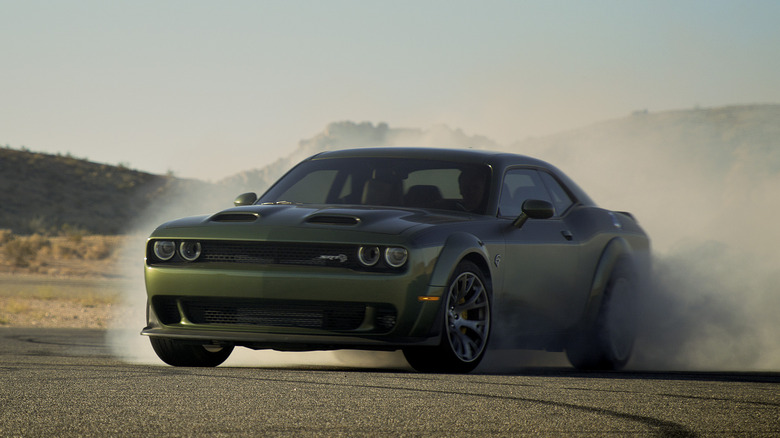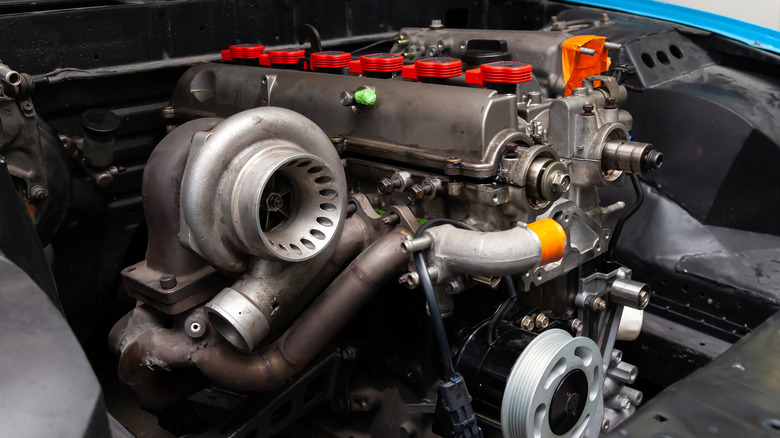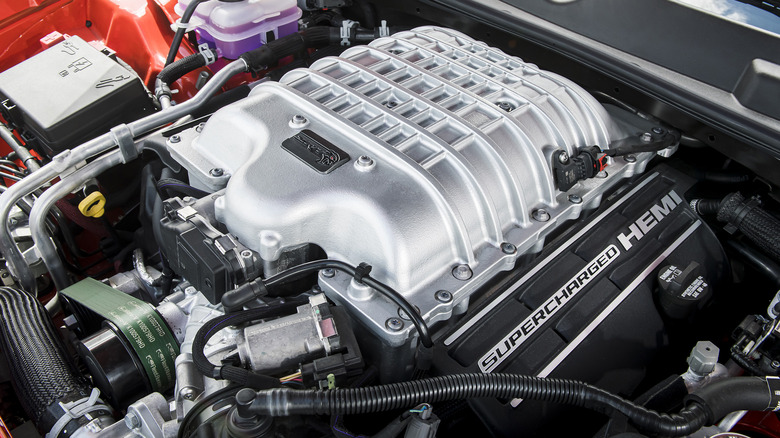Supercharger Versus Turbocharger: Why Car Buyers Should Know The Difference
When automakers or independent wrenching enthusiasts want to add more power to a car, there are usually a few avenues to take to melt the tires off. As the old saying goes: "there's no replacement for displacement" and one could just throw in a larger engine and be done with it. Larger displacement engines allow the pistons to move more and therefore produce more power. Lamborghini has solved most of its power problems with a 6.5-liter V12 chunk of aluminum that produces well over 700 horsepower.
Engines like the aforementioned V12 are naturally aspirated, meaning they rely on the movement of a car to push air into the engine to aid in combustion. Forced induction is the opposite, relying on mechanical aids to put more air into the combustion chamber. There are generally two methods of forced induction commonly used in cars today: supercharging and turbocharging.
If you've spent anytime reading about cars or talking to your local gearhead, you've likely heard or seen heated debates about superchargers versus turbochargers and which one is the best and likely a lot of ill-informed or bad faith arguments on the subject. In reality, each method has its own strengths and weakness and one method is not necessarily "better" than the other in all applications. But what is important to know if you're either shopping for a car, or just want to be more informed on the subject than people arguing in Facebook comments?
Turbochargers: efficiency equals power
Turbochargers are, simply put, a compressor that forces more air into the fuel, air, and spark equation that happens thousands of times a minute in your average internal combustion engines. More air equals more power, and more power is generally the desired outcome. Turbos use exhaust gases from the engine to spin a turbine, which in turn compresses air to go back into the engine. With a turbocharger, the exhaust gases do actually do something instead of being converted into more noise out the tail pipe (which isn't always a bad thing). This efficiency is why companies like General Motors, with its EcoTec line, have turned to equipping smaller displacement engines with turbochargers to get better fuel efficiency and a healthy bump in power.
Turbochargers, generally, produce a lot of torque in addition to power. Diesel engine manufacturers like Cummins use turbochargers to great effect in boosting torque and the pulling power of heavy duty trucks like larger pickups all the way to tractor trailers. The next time you hear a semi truck accelerating or a garbage truck rolling down the road, listen for a high pitched whine, that's the turbocharger spooling up. Trains and locomotives have used diesel engines boosted by huge turbochargers for decades.
One of the downsides of turbocharging is that there is a delay between engine acceleration and the time when the turbo spins up "kicks in." This is often referred to as "turbo lag." Turbochargers are generally best suited for engine efficiency and producing a lot of torque.
Superchargers: more power right now
Superchargers (not the kind from Tesla) are also basically compressors that functionally operate similar to turbochargers, just in a drastically different way. As such, it's best suited for different applications. As opposed to turbochargers which utilize exhaust gasses to spin up, most superchargers use a belt-driven pulley connected directly to the crankshaft of an engine. That itself saps some power (and efficiency) from the engine, but it returns in a big way when it forces more air into the combustion chamber. Prior to turbochargers becoming cheaper over the decades, supercharging was the way to go among old hot-rodders. The famed North American P-51D Mustang World War II fighter plane used a V-12 supercharger — Packard-produced and Rolls-Royce designed — as its powerplant.
In automotive applications, superchargers are often used where physical space and fuel efficiency aren't at the top of the list of concerns. Power delivery through a supercharger also does not have as much of a delay as a turbo. It doesn't need to wait for exhaust gas pressure to build up to spin a turbine as the crankshaft is already doing the work. Cars like the Dodge Challenger SRT Hellcat use a supercharger to great effect in both generating impractical amounts of horsepower and terrifying small animals within a few mile's radius. In muscle cars like the Hellcat, superchargers often emit distinctive howl. If you need power and you need it right now, superchargers are generally the way to go.


